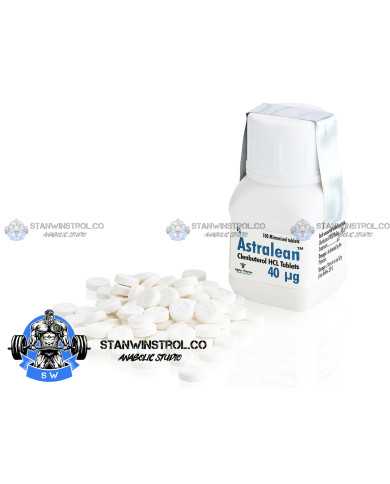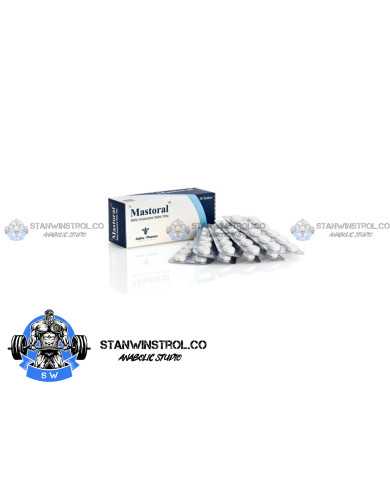OVERVIEW AND HISTORY OF HALOTESTIN
Halotestin is a synthetic derivative of Testosterone, but it is in particular actually a derivative of Methyltestosterone (Testosterone that has been Methylated). It is generally regarded as a very strong oral anabolic steroid that is unable to aromatize into Estrogen and also exhibits very strong androgenic strength as well. Halotestin in particular possesses an anabolic strength rating of 1900 and an androgenic strength rating of 850. When this is compared with its parent hormone Testosterone, any individual can easily see how immensely powerful Halotestin is both in regards to its anabolic muscle building capabilities as well as its androgenic capabilities as well. Comparatively, Testosterone’s anabolic and androgenic strength ratings are 100 respectively, which easily demonstrates the fact that Halotestin is an incredibly colossal 19 times stronger than Testosterone itself, and its androgenic strength is a lesser but equally formidable 8.5 times the strength of Testosterone. This makes Halo an extremely potent anabolic as well as a very strong androgen – stronger than Trenbolone, which is considered the strongest conventionally and commercially available anabolic steroid available.
Halotestin’s very first details were published and released in 1956 as Fluoxymesterone when shortly afterwards the compound was studied and assessed in laboratories to have been found to possess almost 20 times the anabolic strength of Methyltestosterone. However, it has been found that its anabolic strength in humans is not as strong as the numbers theoretically indicate, where it was found that in humans, Halo was found to be up to 5 times the anabolic and androgenic strength of Methyltestosterone (note that Methyltestosterone is used as the reference base here and not Testosterone itself, and it must be understood that Methyltestosterone is slightly stronger than Testosterone itself). After its release of information and details, it was marketed by Upjohn in the American prescription drug market under the trade name Halotestin, and shortly following afterwards, Ciba then created and released their own Halotestin product under the name Ultandren. Halotestin under the prescription descriptions was referred to as a halogenated analogue of Methyltestosterone. Halogenation refers to a specific chemical modification/process in organic chemistry that will be explained shortly.
The very first medical prescription guidelines and treatment for medical indications were for the maintenance and gaining of lean mass and tissue repair following various conditions of trauma (burns, bone fractures, malnutrition, muscle-wasting diseases, treatment of paraplegics, and as an adjunct to chronic administration of corticosteroids). Halotestin was medically utilized in both male and female sexes, where in males its use was indicated for the treatment of insufficient androgen production (hypogonadism or andropause). In females, Halo would be approved for use in treating chronic dysfunctional uterine bleeding as well as female breast cancer.
As was common with all anabolic steroids, Halotestin’s list of approved treatments for various medical conditions in the mid-1970s and 1980s were limited and restricted by the FDA due to the increasing control granted to the FDA over the prescription drug markets. Halotestin’s approved list of treatments was then dwindled down for use in the following: treatment for androgen deficiency in men, breast cancer treatment in females, and to a lesser extent, for the treatment for osteoporosis in post-menopausal women. Furthermore, the lists of approved medical uses for Halotestin today have been further reduced, leaving only the treatment of male androgen deficiency and female breast cancer treatment.
The issue with Halo is that of its high degree of hepatotoxicity, and through this, its high potential for altering cholesterol profiles negatively. It is for these reasons that physicians and medical professionals have elected to avoid the use of Halotestin for any treatment except for that of male androgen deficiency. Even Halotestin’s use for andropause or hypogonadism has become limited in the face of simple TRT (Testosterone Replacement Therapy), whereby simple Testosterone administration is not liver toxic in comparison to Halotestin. Halotestin today still remains available on the prescription market in the United States, still sold by the original manufacturer (Upjohn), but now under the new company name Pharmacia and only in very small and very limited quantities.
CHEMICAL CHARACTERISTICS OF HALOTESTIN
As previously touched upon, Halotestin is a Testosterone derivative whereby it has undergone several modifications. Halo possesses an added methyl group on the 17thcarbon (known as carbon 17-alpha). It is also halogenated at carbon 9-alpha. Halogenation refers to the reaction of an organic compound (in this case, Testosterone) with a halogen, usually resulting in said halogen becoming bound to the compound. A halogen refers to a specific category of 5 related elements on the periodic table (Fluorine, Chlorine, Bromine, Iodine, and Astatine). In Halotestin’s case, this is essentially Testosterone that has been halogenated with Fluorine (as a fluoro group) whereby the Fluorine atom has been bound to carbon 9-alpha. The final modification that Halotestin possesses is its addition of a hydroxyl group (an oxygen atom bound to a hydrogen atom) at carbon 11-beta on the Testosterone molecule.
The addition of the methyl group at carbon 17-alpha is what grants the hormone with the ability to survive metabolism in the liver, and therefore allow the hormone to be ingested orally and have the majority of the hormone successfully reach the blood stream to do its job in the body. Unfortunately it is this modification that also increases the hepatotoxicity (liver toxicity) of the anabolic steroid due to the fact that this modification allows the hormone to become further resistant to hepatic metabolism, and when a substance becomes further resistant to hepatic metabolism, increased liver strain and toxicity results.
The halogenation previously mentioned is what is responsible for the massive increase in androgenic and anabolic strength in comparison to Testosterone and Methyltestosterone. Finally, the addition of the hydroxyl group at carbon 11-beta is what is responsible for restricting the ability for Halotestin to interact with the aromatase enzyme, and therefore become unable to convert into Estrogen in the body.
PROPERTIES OF HALOTESTIN
As previously mentioned, Halo is an extremely strong and potent anabolic steroid analogue, possessing an anabolic strength 19 times the strength of Testosterone, and an androgenic strength 8.5 times the strength of Testosterone. However, it has also been clarified that it has been determined to possess slightly less anabolic strength in humans in practicality. Athletes and bodybuilders should enjoy experiencing a vast increase in strength, lean muscle growth, and an increase in definition. Size increases have purported to be modest but not extreme.
The methylation of the 17th carbon (also known as C17-alpha alkylation) presents the disadvantage of Halotestin causing a degree of hepatotoxicity in the body, and this has been covered. The degree to which this hepatotoxicity presents itself will be further expanded upon in the Halotestin side effects section of this article. This is a factor that must be considered and kept in mind by any potential users who which to use Halotestin.
Finally, because of its inability to interact with the aromatase enzyme and thereby avoid any Estrogen conversion, no risk of any Estrogen-related side effects at any dose should be seen with Halo. This means that users can expect no water retention that would lead to the puffy, bloated, and soft look that is often undesirable, especially during periods of cutting and fat loss, and pre-contest phases for competitive bodybuilders.
HALOTESTIN (AKA FLUOXYMESTERONE)
CHEMICAL NAME: 9A-FLUORO-11B, 17B-DIHYDROXY-17A-METHYL-4-ANDROSTEN-3-ONE, 9A-FLUORO-11B-HYDROXY-17A-METHYLTESTOSTERONE
MOLECULAR WEIGHT: 336.441 G/MOL
FORMULA: C20H29FO3
ORIGINAL MANUFACTURER: UPJOHN
HALF LIFE: 9.5 HOURS
DETECTION TIME: 2 MONTHS
ANABOLIC RATING: 1,900
ANDROGENIC RATING: 850
371
Reviews
No customer reviews for the moment.

















